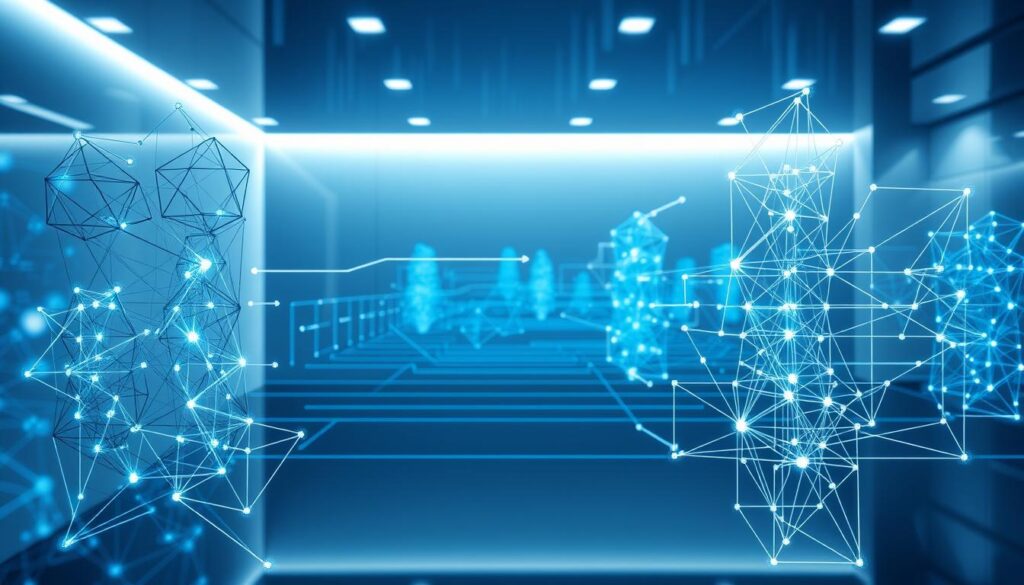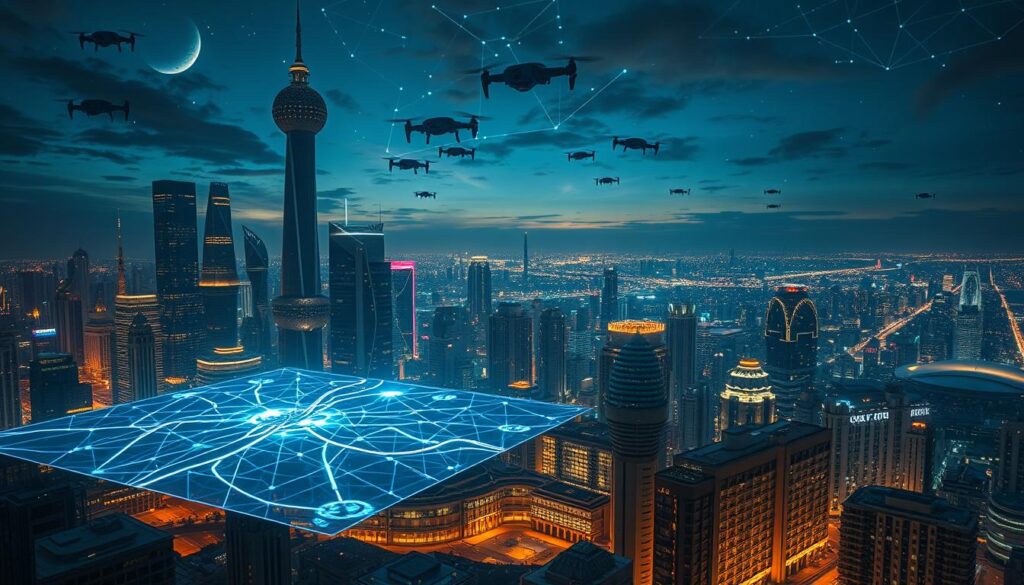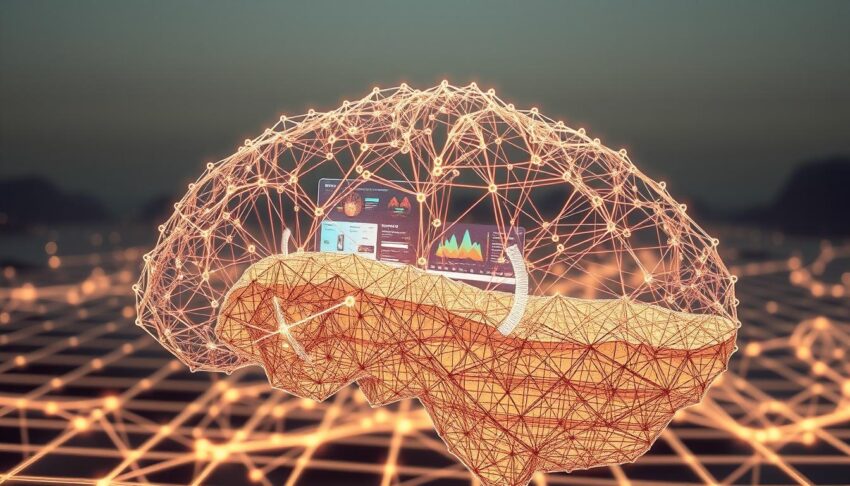What if the secret to unlocking AI's full power is in a brain-like structure? Neural networks are the heart of AI, letting machines learn and grow. They use lots of data to find new insights, changing fields like healthcare and finance.
Knowing how neural networks work is key in our data-filled world. They help us understand AI better.
Key Takeaways
- Neural networks replicate the human brain's structure for processing information.
- They serve as a foundational component of modern artificial intelligence technology.
- Interconnected nodes in neural networks enable adaptive learning from large data sets.
- Applications of neural networks are transforming sectors like healthcare and finance.
- Understanding these systems is crucial for leveraging AI's capabilities effectively.
Understanding the Fundamentals of Neural Networks
Neural networks are key to many AI advances. They have layers: input, hidden, and output. Each layer has many neurons that do complex math.
These neurons use special functions to change data. The connections between them have weights that change during training. This helps the network learn from data.
Looking at the network's structure, we see how it works. It makes paths for data to flow. This lets it predict or classify things well. Knowing this helps us explore AI's full power.
The Role of Neural Networks in Artificial Intelligence
The role of neural networks is huge. They help machines do things we thought only humans could do. They look at lots of data and make smart choices.
Neural networks are key in making AI better. They help AI understand big amounts of data. This lets AI help in many areas, like health and money.
They also make AI talk and see better. This makes AI systems work better with us. Neural networks are changing AI for the better.
How Neural Networks Enhance Machine Learning
Neural networks are key to making machine learning better. They help with supervised and unsupervised learning. This makes data-driven apps smarter.
Supervised vs. Unsupervised Learning
Supervised learning uses labeled data to get better at predicting. The model learns from mistakes. This makes it more accurate over time.
Unsupervised learning looks at data without labels. It finds patterns and connections. This is useful when labeling data is hard.
The Importance of Data in Training Neural Networks
Good data is crucial for training neural networks. A strong dataset helps the model perform well. Bad data can mess up the learning process.
Steps like cleaning and preparing data are important. They help the model work well on different tasks. This makes machine learning more effective.
Deep Learning: A Layered Approach to Neural Networks
Deep learning is a big step in artificial intelligence. It uses many layers to understand complex data. This makes it better at recognizing patterns and improving how things work.
Tools like TensorFlow and PyTorch help make deep learning easier. They let people create and train complex models. This has made deep learning more popular, leading to new ideas in computer vision and speech recognition.
Learning about deep learning is very useful. It helps us use neural networks to their fullest. This leads to new tech and data science discoveries.

Applications of Neural Networks in Natural Language Processing
Neural networks are key in making computers talk like us. They help computers understand and make human language. This makes using computers better for everyone.
Text Analysis and Sentiment Detection
Neural networks are changing how we read text. They can understand lots of text very well. This helps businesses know what people think about their products.
They can tell if people are happy, sad, or neutral. This helps companies make better choices for their customers.
Voice Recognition Systems
Voice recognition uses neural networks to turn speech into text. It makes talking to devices easy and natural. This technology is getting better all the time.
Soon, it will be even more accurate and fast. This will change how we talk to our devices every day.
Computer Vision: Transforming Images with Neural Networks
Computer vision uses neural networks to understand images. It lets machines see and understand pictures and videos. Convolutional neural networks (CNNs) help machines spot objects, scenes, and activities very well.
Image recognition shows how neural networks change how we look at pictures. It helps in facial recognition, watching places, and checking medical images. This makes looking at pictures faster and more accurate.
Here's a table showing how computer vision and neural networks help in many ways:
| Application | Description | Impact |
|---|---|---|
| Facial Recognition | Identifies and verifies individuals based on facial features. | Enhances security and personal identification processes. |
| Automated Surveillance | Monitors areas using camera feeds to detect unusual activities. | Improves safety and reduces the need for constant human oversight. |
| Medical Imaging Diagnostics | Analyzes medical images (e.g., X-rays, MRIs) for diagnostic purposes. | Supports accurate diagnoses and prompts timely treatments. |
Pattern Recognition Capabilities of Neural Networks
Neural networks are great at recognizing patterns. They are used in many fields. This includes facial recognition and automated image sorting. These uses show how neural networks change how we process images and keep data safe.
Applications in Facial Recognition
Facial recognition uses neural networks to find and identify faces in pictures. It looks at special features of the face to match them with big databases. This tech is used in many places, like security systems and social media.
Big companies like Facebook and Apple work hard on this. They make it better for everyone. Some good things about it are:
- Enhanced security by checking who you are right away.
- Seamless user experience when you unlock devices or pay for things.
- Efficient integration into many systems, like watching over places.
Automated Image Classification
Neural networks also help sort images into groups. This makes it easier to deal with lots of pictures. It's useful in places like online shops, hospitals, and places that manage lots of pictures.
They look at things like color, shape, and texture. This makes sorting pictures more accurate. Some benefits are:
- Improved operational efficiency by not having to sort pictures by hand.
- Higher accuracy in sorting pictures compared to old ways.
- Streamlined workflows in finding and getting information from lots of pictures.
These uses show how neural networks help in many areas. Facial recognition and image sorting are just the start. They show how we can keep getting better at handling images.
Data Analysis Revolutionized by Neural Networks
Neural networks have changed how we analyze data. They help find deep insights in big datasets. These smart algorithms spot trends and patterns that old methods miss.
In finance, neural networks are key in catching fraud. They help companies save a lot of money. In market research, they dive deep into what customers do and want.
Neural networks are great at predicting what will happen next. They make analysis faster and find hidden links. This helps companies make better choices. Using neural networks makes businesses more efficient and innovative.
Challenges Facing Neural Networks in Development
Neural networks are changing the game, but they face big challenges. One big problem is overfitting. This happens when a model does great on training data but fails outside.
Getting a model to work well in real life is hard. It needs lots of good data, which takes time and money. Finding the right data is a big hurdle.
Another issue is how much energy these networks use. As they get bigger, they eat more power. This makes people worry about their impact on the planet.
| Challenge | Description | Impact |
|---|---|---|
| Overfitting | Model's tendency to perform well on training data but poorly on unseen data. | Reduced generalization and accuracy in practical applications. |
| Data Requirements | Need for large, labeled datasets for effective training. | Increased time and resource consumption for data processing. |
| Computational Costs | High energy consumption associated with large-scale model training. | Concerns about sustainability and environmental impact. |
Future Trends in Neural Network Technology
The world of neural network tech is about to change a lot. New hardware is coming that will make things work better and faster. This will help create smarter neural network models.
Advancements in Hardware for Neural Processes
New tech like special neural processing units (NPUs) is leading the way. These units make computers work faster and use less power. This is key for handling complex neural networks.
As companies need to process data quickly and use complex algorithms, this tech is crucial. It will help make neural networks even better in the future.
The Rise of Explainable AI
There's also a big push for explainable AI. People want to know how AI makes decisions, especially in important areas like health and money. This is because AI needs to be trusted and understood.
Explainable AI helps solve these problems. It makes AI more accountable and trustworthy. This is good for using AI in our daily lives.

Ethical Considerations Surrounding Neural Networks
Neural networks are used more and more in different areas. This raises big ethical questions. It's important to make sure these networks are fair and accountable.
These networks use a lot of data. If this data is biased, the results can be wrong. This is a big problem in jobs, law, and money matters.
To fix data bias, we need to act fast. We must find ways to reduce bias when making these networks. It's key for developers and companies to watch for and fix bias.
Testing and checking AI systems is also crucial. This makes sure they work well for everyone. It helps make AI fair and open to all.
We also need to think about privacy and getting people's consent. As neural networks become part of our lives, we must respect people's rights. Being ethical helps build trust and makes AI better for everyone.
Neural Networks: The Future of AI
The future of AI depends a lot on neural networks. These systems are key for machine learning. They can turn big data into useful information.
Neural networks can handle complex data well. This opens up new chances for AI in many fields.
Healthcare can get better at finding diseases. Businesses can run their supply chains better. Neural networks make systems smarter and understand what we want.
More work on making neural networks better is needed. This will bring even more chances for AI. The path of neural networks looks very promising for AI's future.
Conclusion
Neural networks play a big role in artificial intelligence. They are the base for many tech uses today. This includes things like understanding language and seeing pictures.
Looking at AI, we see how neural networks change things. They will make new things possible and better our lives. But, we must use them right to help everyone.
Neural networks mix science, tech, and helping people. As they grow, they will change AI and tech. We need to think about how to use them well for everyone's good.
